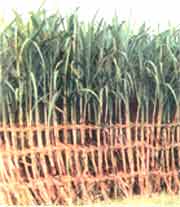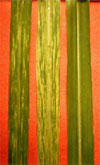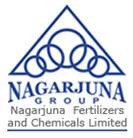|
Introduction
- Among various riputes of sugarcane production, although
fertilizers contribute maximum to the increase in yield
but these cannot help to maintain and enhance soil organic
matter content which is ultimate key to sustainability.
- Organic matter maintains porous soil structure, provides
superior water holding capacity and allows oxygen to
penetrate for use by soil microbes that break down manure,
crop residues and other organic matter.
- Infact, earlier to the introduction of chemical fertilizers
in cane cultivation the fertility of fields used to
be sustained not only by animal and plant wastes, but
also by certain practices of mixed cropping, crop rotation
etc.
- These practices have in fact been followed for centuries
in India but have been rapidly given up in recent years
due to input-intensive agriculture.
- There is no doubt that sugarcane crop needs fertilizers.
A crop of 125 tonnes per hectare removes 83 kg nitrogen,
37.2kg phosphorus and 168 kg potassuim per hectare from
soil.
- The tendency to supply all these nutrients through
chemical fertilizers, however, has to be avoided as
these have deleterius effect on soil productivity on
long-term basis.
- However, to sustains sugarcane production under intensive
cultivation as practiced in the hot climate of India,
organic matter content of soil must be maintained either
by recycling organic wastes, use of farm yard manure,
green manuring, growing legumes in crop sequences and
as companion crops.
Role of Major Nutrients
Nitrogen
 |
- Influences sugrcane yield and quality.
- Required for vegetative growth (tillering,
foliage formation, stalk fromation and growth)
and root growth.
- Vegetative growth in sugarcane is directly
related to yield.
|
- Deficiency of Nitrozen leads to:
i. paleness of foliage.
ii. early leaf senescence
iii. thinner and shorter stalk
iv. longer but thinner roots
- Excess Nitrozen leads to:
i. harmful to crop
ii. prolongs vegetative growth
iii. delays maturity and ripening
iv. increases reducing sugar content in
juice
v. lowering juice quality
vi. increases soluble N in juice affecting
clarification
vii. susceptible to lodging, pest and disease
incidence
Phoshhorus
- Uptake depends on presence of soluble and plant absorbable
form.
- P- requirement is relatively less than N and K.
- Necessary for formation of proteins and thus for yield
build up.
- Important for cell division leads to crop growth
- Stimulates root growth
- Necessary for plant metabolism and photo synthesis
- Required for adequate tillering
- Interacts with N and thus enhance ripening.
- Deficiency of P leads to:
i. reduced tillering
ii. delays in canopy development, excess
weed growth
iii. affects stalk elongation.
iv. less production of secondary and tertiary
stalks
v. leaves grow closely
vi. leaf colour appears green violet
vii. for proper clarifiction while processing 300-400
ppm of phosphorus viii. in cane juice is
necessary.
Excess P is wasted due to fixation in soil
Potassium
- Requirement of K is greater than N and P.
- Required for carbon assimilation, photo synthesis translocation
of carbohydrates
- Involved in various enzymatic activities
- important for sugar synthesis and translocation to the storage
organs.
- develops resistance to sugarcane against pest, disease and
lodging.
- Maintains cell turgidity under moisture stress conditions.
- Balances the effect of N and P
- Excess availability of K leads to "Luxury consumption".
NPK requirements
- NPK requirements depends on variety, soil type, irrigation
level etc. The requirements of nutrients not only met by the
application of manures and fertilizers but also fertility
status.
Dosage
- Dosage of nutrient to be supplied will be determined based
on crop requirement contribution from the soil and organic
manures applied, likely losses of applied nutrients by means
of leaching, volatililization, fixation etc.
Time for Fertilizer Application
- Timing is based on crop need at different growth phases,
and best use of applied nutrient with less wastage.
- Nitrogen requirement is maximum at tillering and early grand
growth phase viz., within the first six months. upto tillering
the nitrogen need is much limited and hence application at
planting may not be required in most cases.
- If at all N needed from the beginning by the crop 10% of the
total dose can be applied at planting by placing near the
sett.
- Between 3-4 months age (tillering phase) high amount of N
uptake is observed and hence, the first application of nitrogen
should be at the start of tillering viz., at 45 days of planting.
- In case of short duration, early maturing varieties first
application of N can be given at 30 days age of the crop.
- Beginning of the grand growth period viz the end of tillering
phase the N-requirement is very high and this can be met by
applying N between 90-120 days period for Eksali crop.
 |
- Potassium
application normally done along with N application
because of better utilisation of N in the presence
of K. Therefore K is applied at 45th and 90th day.
- In sugarcane late application of K at around 6 months
has been found to improve sugar recovery particularly
under drought situations.
|
- Late application or N beyond 120 days (Eksalicrop) will
have adverse effect on juice quality because of continued
vegetative growth, late tillering, reduce 5% of Juice, increased
soluble nitrogen in juice, water shoot formation etc.
- Farmers should realise that late application of N will do
more harm than good.
- Most of the late applied N goes to late tillers and water
shoot formation besides becoming susceptible to pests and
diseases.
- The time of N application however, can be extended to six
months in case of adsali crop.
- Small quantities of N along with P and K can be applied late
for recovery of crops suffered due to flood and water logging.
This should be done only when there is sufficient time between
harvest and the time of application.
- Fertilizer application should invariably followed by irrigation
and excess irrigation should be avoided to avoid leaching
losses.
Method of application
- Apply phosphorus in the furrow bottom and mix slightly
with soil before planting.
- Nitrogen and potassium fertilizers are given in split doses,
applied in bands on either side of the cane row.
- Cover the fertilizer with soil immediately after placement
to reduce volatilization losses. This is also achieved by
partial earthing after first top dressing and full earthing
up after second top dressing.
Micro Nutrients
 |
- Iron chlorosis
particularly line induced chlorisis in calcarious
soil leads to interveinal chlorisis, stunted growth.
- This could be corrected by repeated spray application
of ferrous sulphate at 0.5% - 10% concentration.
- Application of cured press mud or FYM reduces chlorisis.
Chlorosis may also occur due to nematodes.
|
- Zinc deficiency is another important micronutrient problem
in soils where paddy is grown in rotation. To overcome zinc
deficiency 0.5% ZnSo4 , spray can be done.
- Zinc spray can also be done along with ferrous sulphate spray.
Ferrous sulphate and zinc sulphate together can be applied
to soil at 25kg each per hectare.
Foliar nutrition
- Foliar nutrition of urea (1 to 2.5%) and potassium (2.5%)
under moisture stress is a useful practice to improve yield
and quality.
- Foliar application of DAP formed to be useful to improve yield
and quality.
- Good foliage wetting is necessary. 'Teepol' can be used as
a wetting agent.
- Sprayings done preferably in the morning hours.
- A boom sprayer may be used in a grown up crop.
Tissue analysis guide to deficient and non-deficient sugarcane during active growing period
|
CropNutrient
|
CropPlant part numhbered from
top down
|
CropCritical concentration
|
CropRange showing deficiency symptom
|
Range without deficiency symptom
|
| Nitrogen |
Blades 3,4,5,6
|
1.0%
|
1-1-5%
|
1.5-2. 7%
|
| Phosphorus
|
Sheaths 3,4,5,6 Intermodes 8-10
|
0.08%
0.04%
|
0.02-.05%
0.10-.32%
|
0.05-0.2%
0.04-0.2%
|
| Potassium |
Sheaths 3,4,5,6
Internodes 8-10
|
2.25% 1.00%
|
0.3-1.5% 0.3-0.8%
|
2.25-6% 1-2%
|
| Calcium |
Sheaths 3,4,5,6 Internodes 8-10
|
0.15%
|
0.02-0.1%
0.05%
|
.1-2%
0.05-2%
|
| Magnesium |
Sheaths 3,4,5,6
Internodes 8-10
|
0.1%
0.05%
|
|
0.15-1.0%
0.10-1%
|
| Sulphur |
Blades 3,4,5,6
|
|
20-100 ppm
|
300-10,000ppm
|
| Zinc |
Sheaths 3,4,5,6
|
10 ppm
|
<10ppm
|
10-100ppm
|
| Iron |
Blades 3,4,5,6
|
@ |
1-10pm |
20-600ppm
|
| Boron |
Blades 3,4,5,6
|
1 ppm |
<1 ppm
|
2-30 ppm
|
| Copper |
Blades 3,4,5,6
|
5 ppm |
<3.5 ppm
|
5-100 ppm
|
| Manganese
|
Blades 3,4,5,6
|
@ |
1-10 ppm
|
20-400ppm
|
| Molybdenum
|
Blades 3,4,5,6
|
0.05 ppm |
<0.05ppm
|
0.05-4 ppm
|
@Varies with Fe/Mn ratio, Critical level can be below 10ppm if Fe/Mn remain>1 (Source : Schmehl and Humbert, 1964)
 Top
Top
|

